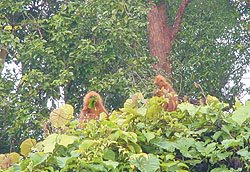just next to the dormitory. Photo & Copyright: Hj Ramlee
An adult Maragang or Maroon Langur reacts with its classic posture.
Photo & Copyright: Hj Ramlee
By Meiji and Hj Bahrin HB
At a glance one could have stumbled upon a red primate in the countryside or interior believing it was an Orangutan. On record, perhaps the most reliable encounter of a solitary Orangutan was claimed by Awg Hj Pudin bin Zainal who said he saw one at Selangan forest, in Temburong way back in 1923. His description of the primate - red fur, no tail, a bit bigger than other primates found here in Brunei Darussalam, does not jump but moves and swings most of the time from tree to tree - is most likely to be the last red ape seen in the wilderness of this country.
But what has happened then?
Nobody had seen such an ape since. Could it be that the rare sighting was of another red primate - the Maragang (the species of Presbytis rubicunda meaning red langur)? However, the Maragang which has a similar coloration with a long tail and of which the dominant males live with a harem do not occur in that part of the lowland Temburong forest except in the mountain ranges of Bukit Retak and Gunong Pagon.
Where else can you see this red ape?
The Maragang (which also means red in the native Dusun language) or commonly known as Maroon Langur (for its reddish to golden brown furs) is not found in Brunei-Muara district either. Rapid development has immensely changed the natural landscape into less diverse fragmented forest habitats that could have been the main factor which pushed them further inland in the Tutong and Belait districts. There are now several harems living around Tasek Merimbun Heritage Park Centre. One of the harems is often seen just next to the dormitory inhabited by a few of the Brunei Museum staff.
There are two distinct groups of monkeys in Borneo; the langurs or leaf monkeys and the Proboscis Monkey and the macaques. The Langur consists of five species; Presbytis hosei, Presbytis frontata, Presbytis cristata, Presbytis melalophos and Prebytis rubicunda. Three of the species are found in Brunei Darussalam, they are Presbytis hosei, Presbytis cristata and Presbytis rubicunda. The later two species are found in Tasek Merimbun.
The Maragang has a dark face or a bluish tinge. The adult's head has a cone-shaped hood fur that an Orangutan does not have. The infants are whitish with black markings down the back and across the shoulders. Still clinging to their mum's shoulder since their birth, the infants then transform into a reddish coloration after about six months old. They learn to move independently after about one year but always staying close to their mums and enjoying the company of their other younger siblings. They usually live with a group of about eight with only one adult male.
Researchers have found that the Brunei group size is slightly richer than that of the neighbouring countries and this could be due to the healthy and well-maintained ecosystem in its natural state. In Tasek Merimbun, the known habituated group size consists of ten individuals. They spend their night on tall trees preferably an emergent.
The Maragang feeds throughout the day mostly on young leaves of both primary and secondary forests, but they also known to come down to certain tree plantations and gardens to eat young leaves and seeds. In Tasek Merimbun, the Maragang feeds on young leaves, flowers and as well as fruits of the species Merremia borneensis, Merremia peltata, Koompassia malaccensis, Havea brasilensis, Dillenia suffruticosa, Plectomia mulleri, Uncaria sp and other species from the families of Myrtaceae, Oxalidaceae, Urticaceae and Moraceae. They even feed on poisonous young leaves of the Parartocarpus venenosus.
This red primate is listed in the IUCN Red Book, meaning they are endangered and are legally protected worldwide. Their occurrence in most conservation areas of Brunei Darussalam provides a better chance of their longterm survival particularly at Tasek Merimbun that has been declared as one of the most outstanding ASEAN Heritage Parks since 1984.
The Maragang in Brunei Darussalam have always been very fortunate because indigenous people do not eat or hunt them and they never been considered as pests. Primate enthusiasts or visitors who may wish to enjoy seeing this red primate could seek advice from the managers of the park for further sighting schedules.
Courtesy of Borneo Bulletin Weekend


No comments:
Post a Comment